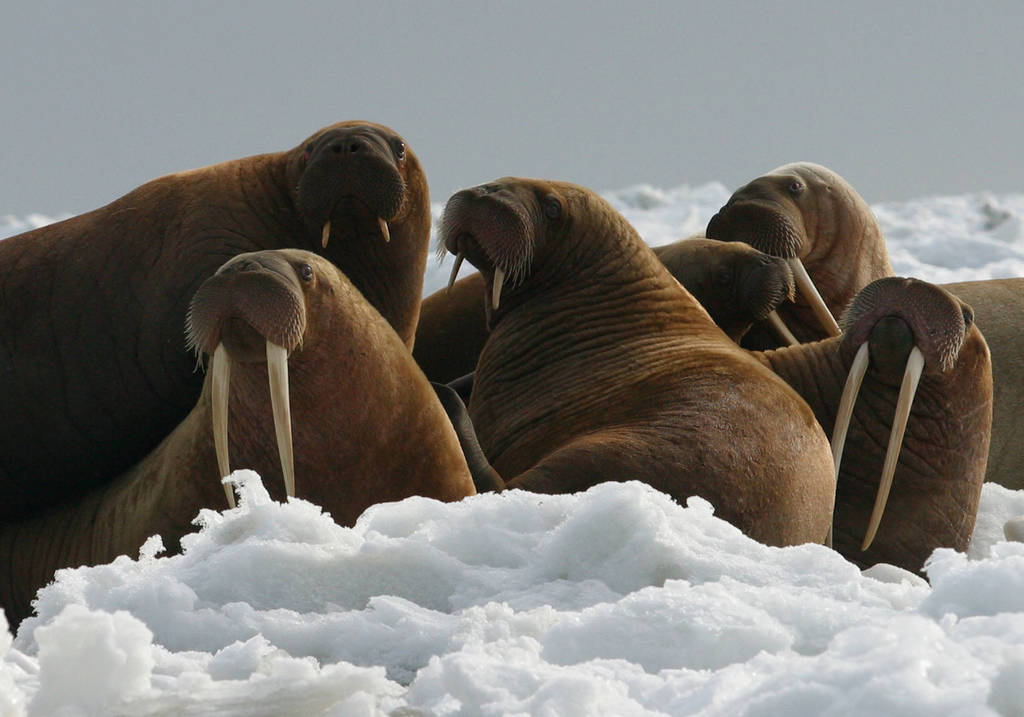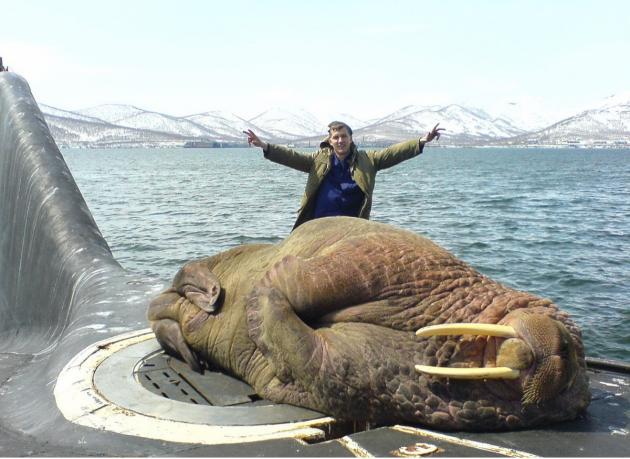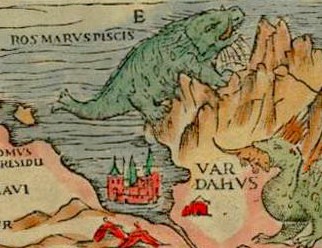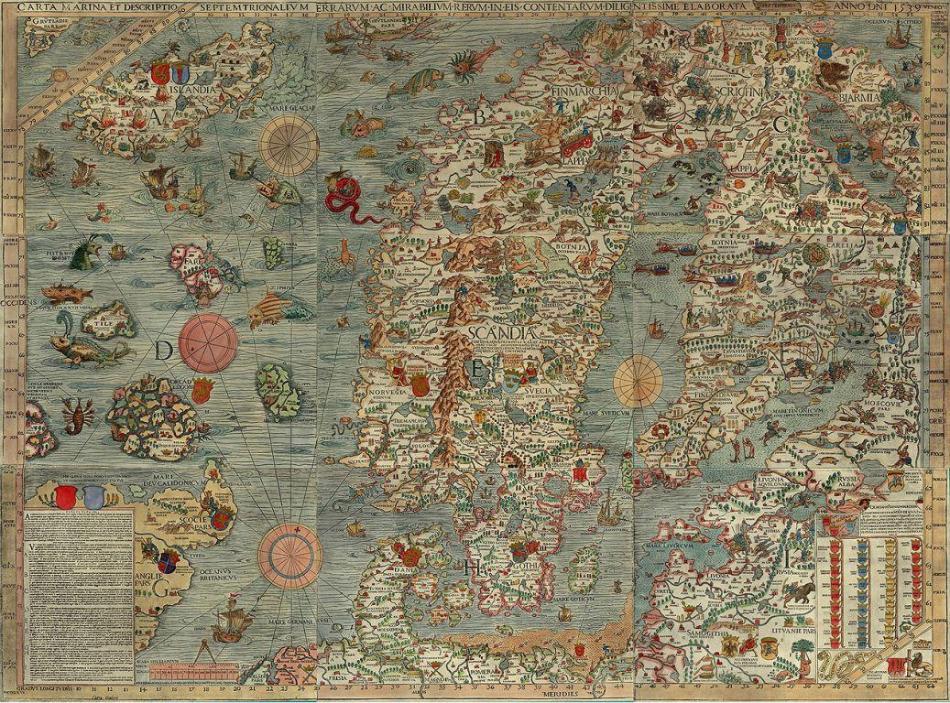July 26 - August 1, 2015: Issue 224
Summer in the Northern Hemisphere – Walruses and the Carta Marina

Photo credit: U.S. Fish and Wildlife Service USFWS/Joel Garlich-Mille Headquarters - Flickr: Walrus Cows and Yearlings on Ice.
Summer in the Northern Hemisphere – Walruses and the Carta Marina
The walrus (Odobenus rosmarus) is a large flippered marine mammal with a discontinuous distribution about the North Polein the Arctic Ocean and subarctic seas of the Northern Hemisphere.
 The walrus is the only living species in the Odobenidae family and Odobenus genus. This species is subdivided into three subspecies: the Atlantic walrus (O. r. rosmarus) which lives in the Atlantic Ocean, the Pacific walrus (O. r. divergens) which lives in the Pacific Ocean, and O. r. laptevi, which lives in the Laptev Sea of the Arctic Ocean.
The walrus is the only living species in the Odobenidae family and Odobenus genus. This species is subdivided into three subspecies: the Atlantic walrus (O. r. rosmarus) which lives in the Atlantic Ocean, the Pacific walrus (O. r. divergens) which lives in the Pacific Ocean, and O. r. laptevi, which lives in the Laptev Sea of the Arctic Ocean.
In late spring and summer, for example, several hundred thousand Pacific walruses migrate from the Bering Sea into the Chukchi Sea through the relatively narrow Bering Strait. In late spring and summer, for example, several hundred thousand Pacific walruses migrate from the Bering Sea into the Chukchi Sea through the relatively narrow Bering Strait.
Right: A walrus asleep on a Russian submarine, photographed this week.
The rest of the year (late summer and fall), walruses tend to form massive aggregations of tens of thousands of individuals on rocky beaches or outcrops. The migration between the ice and the beach can be long-distance and dramatic.
Walruses live to about 20–30 years old in the wild. The males reach sexual maturity as early as seven years, but do not typically mate until fully developed at around 15 years of age. They rut from January through April, decreasing their food intake dramatically. The females begin ovulating as soon as four to six years old. Breeding occurs from January to March, peaking in February. Males aggregate in the water around ice-bound groups of estrous females and engage in competitive vocal displays. Gestation lasts 15 to 16 months. The first three to four months are spent with the blastula in suspended development before it implants itself in the uterus. This strategy of delayed implantation, common among pinnipeds, presumably evolved to optimize both the mating season and the birthing season, determined by ecological conditions that promote newborn survival. Calves are born during the spring migration, from April to June. They weigh 45 to 75 kg (99 to 165 lb) at birth and are able to swim. The mothers nurse for over a year before weaning, but the young can spend up to five years with the mothers. Because ovulation is suppressed until the calf is weaned, females give birth at most every two years, leaving the walrus with the lowest reproductive rate of any pinniped.
Adult walruses are easily recognized by their prominent tusks, whiskers, and bulkiness. Adult males in the Pacific can weigh more than 2,000 kg (4,400 lb) and, among pinnipeds, are exceeded in size only by the two species of elephant seals. Walruses live mostly in shallow waters above the continental shelves, spending significant amounts of their lives on the sea ice looking for benthic bivalve mollusks to eat. Walruses are relatively long-lived, social animals, and they are considered to be a "keystone species" in the Arctic marine regions.
The walrus has played a prominent role in the cultures of many indigenous Arctic peoples, who have hunted the walrus for its meat, fat, skin, tusks, and bone. During the 19th century and the early 20th century, walruses were widely hunted and killed for their blubber, walrus ivory, and meat. The population of walruses dropped rapidly all around the Arctic region. Their population has rebounded somewhat since then, though the populations of Atlantic and Laptev walruses remain fragmented and at low levels compared with the time before human interference.
Genus: Odobenus Brisson, 1762
Mathurin Jacques Brisson (30 April 1723 – 23 June 1806) was a French zoologist and natural philosopher. Brisson was born at Fontenay-le-Comte. The earlier part of his life was spent in the pursuit of natural history, his published works in this field included Le Règne animal (1756) and the highly regarded Ornithologie (1760).
As a young man, he was a disciple and assistant of R. A. F. Reaumur. For a period of time he was an instructor of physical sciences and natural history to the family of the monarch. He held the chair of physics at the College of Navarre, and from 1759 was a member of the Academy of Sciences.
A significant work involving the "specific weight of bodies" was his Pesanteur Spécifique des Corps (1787).
From: https://en.wikipedia.org/wiki/Mathurin_Jacques_Brisson
 The origin of the word walrus is thought by J.R.R. Tolkien to derive from a Germanic language, and it has been attributed largely to either the Dutch language or Old Norse. Its first part is thought to derive from a word such as Dutch walvis 'whale'. Its second part has also been hypothesized to come from the Old Norse word for 'horse'. For example, the Old Norse wordhrossvalr means 'horse-whale' and is thought to have been passed in an inverted form to both Dutch and the dialects of northern Germany as walros and Walross. An alternate theory is that is comes from the Dutch words wal 'shore' and reus 'giant'.
The origin of the word walrus is thought by J.R.R. Tolkien to derive from a Germanic language, and it has been attributed largely to either the Dutch language or Old Norse. Its first part is thought to derive from a word such as Dutch walvis 'whale'. Its second part has also been hypothesized to come from the Old Norse word for 'horse'. For example, the Old Norse wordhrossvalr means 'horse-whale' and is thought to have been passed in an inverted form to both Dutch and the dialects of northern Germany as walros and Walross. An alternate theory is that is comes from the Dutch words wal 'shore' and reus 'giant'.
A walrus, labeled Ros marus piscis, is depicted in а 16th-century map of Scandinavia (the Carta Marina).
Right: Atlantic Walrus sketch, from Olaus Magnus' 1539 Carta marina; figure B-B
The Carta marina (Latin "map of the sea" or "sea map"), drawn by Olaus Magnus in 1527-39, is the earliest map of the Nordic countries that gives details and place names. Only two earlier maps of Scandinavia are known, those of Jacob Ziegler(Strasbourg, 1532) and Claudius Clavus (15th century).
The map was created in Rome by the Swedish ecclesiastic Olaus Magnus (1490–1557), who arrived on a diplomatic visit for the Swedish government and stayed on, likely because his brother Johannes Magnus became involved in a religious feud with King Gustav I of Sweden.
It is generally considered that Historia de gentibus septentrionalibus ("A description of the Northern peoples") printed in Rome, 1555, is an extensive commentary based in part on features of the map. The Latin notes were translated by Olaus into Italian(1565) and German (1567). In production for 12 years, the first copies were printed in 1539 in Venice.
The map was printed from nine 55x40 cm woodcut blocks to produce a document that is 1.70 m wide by 1.25 m tall.
A faithful reproduction of the map was printed in Rome by Antoine Lafréry in 1572. All of the original map's copies passed out of public knowledge after 1574, and the map was largely forgotten – perhaps because few copies were printed and Pope Paul III asserted a 10-year "copyright." It was later widely questioned whether the map had ever existed.
In 1886, Oscar Brenner found a copy at the Hof- und Staatsbibliothek in Munich, where it currently resides. In 1961, another copy was found in Switzerland, brought to Sweden the following year by the Uppsala University Library; as of 2007 it is stored at Carolina Rediviva.
Walrus cows and yearlings (short tusks). Photo courtesy USFWS

The Carta Marina, From: wikimedia.org/wiki/File:Carta_Marina.